Introducing! … one of the most delicious coconut desserts you will ever come across. Tako is a two-layer Thai coconut pudding that I think is the perfect party dessert. It comes in a variety of flavours (in addition to coconut) and is a popular sweet you can find all over Thailand. It’s an easy dessert that is quick, endlessly adaptable, and also vegan and gluten free!

Upside Down Tako = “Crystal Pudding”
Tako ตะโก้, (also called kuih tako in Malaysia, Indonesia and Singapore), is a coconut pudding with 2 layers. Traditionally, the top is always the same: a white, creamy, salty-sweet coconut pudding (pic below). The bottom, however, can be made with a variety of ingredients and determines the flavour of the tako. Think of it as different flavours of cake using the same frosting – they all look the same…the real flavour is a surprise!
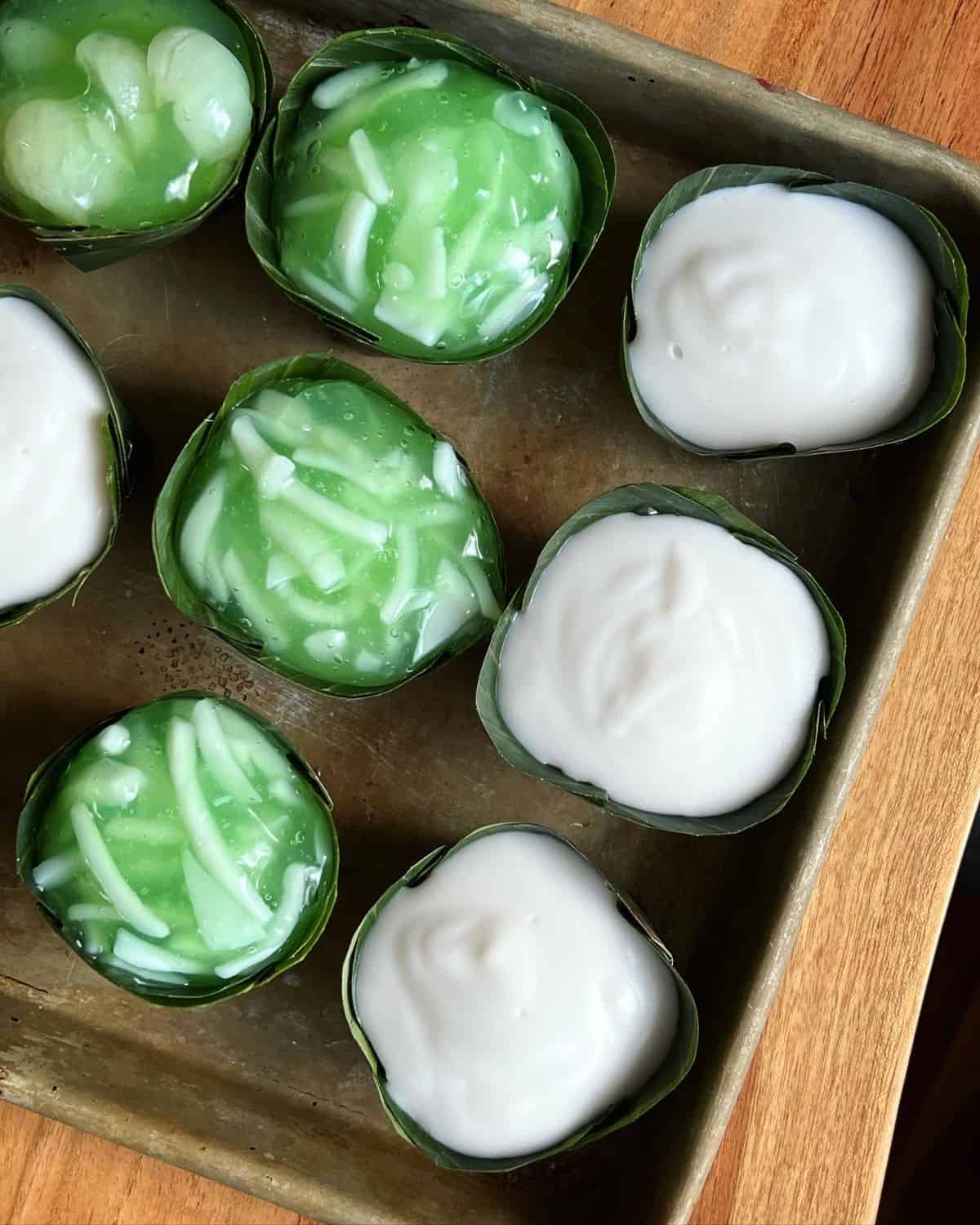

But for this recipe I wanted to turn it upside down, revealing the side that is more colourful and shiney. Upside-down tako is a recent trend in Thailand, and during my last trip home, my cousin brought me some … and I didn’t even recognize them as tako at first! The glossy beauties immediately reminded me of gemstones, so I came up with the nickname “crystal pudding.” I thought it was brilliant and became inspired to make it the “wrong” way myself!
Tako is the perfect party dessert. Here’s why
Bold claim, but let me explain. These little creamy pudding cups are:
- Vegan, gluten-free, and most allergen-free
- Require no baking or any special equipment
- Easy and quick, no dessert experience required
- Endlessly adaptable – a great recipe for creative minds!
- Can be prepped ahead
- Are super tasty!
Now that you’re intrigued, let’s see how they’re made.
Ingredients
There are 2 components to tako: the creamy coconut pudding (usually the top, but for us it is the bottom), and the glossy pudding which can be made into any flavour you can dream up. I have given you 3 options for the top layer, but feel free to come up with your own ideas as well!
Bottom Layer – The Coconut Pudding


- Rice flour
- Water
- Coconut milk, being dessert it is important to use good quality full-fat coconut milk as it will make a difference. See my post here on how to choose good coconut milk.
- Sugar
- Salt
Top Layer Option 1 – Green Pandan Young Coconut
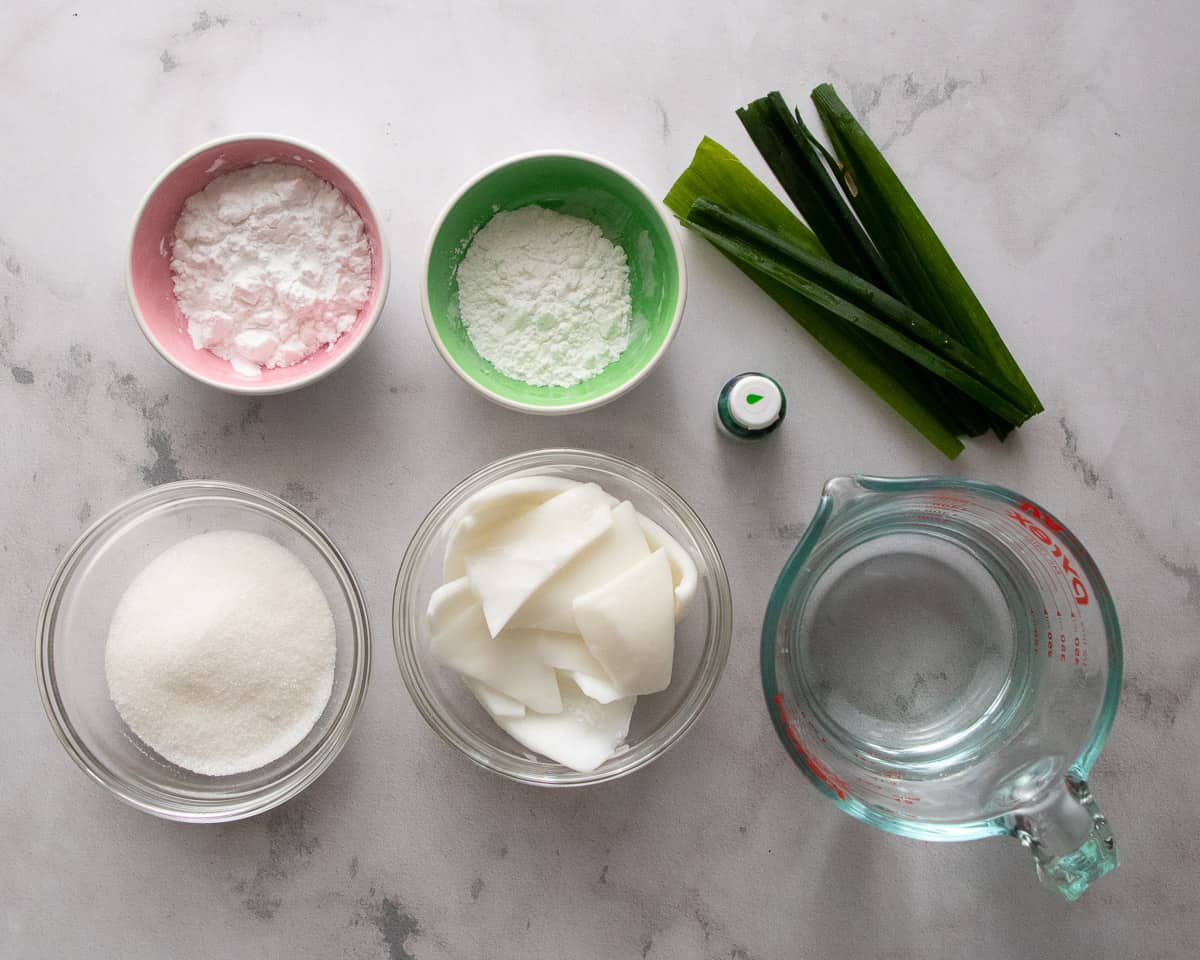

Pandan with young coconut are a classic dessert combination in Thai cuisine. The flavour will give you the most traditional flavour profile, and it is my personal favourite of the bunch.
- Pandan leaf, fresh or frozen will work fine. If not available you can substitute a combination of coconut and vanilla extract.
- Water
- Green food colouring (optional)
- Mung bean starch (more on this below)
- Tapioca starch
- Sugar
- Young coconut meat, I use one that’s canned in syrup, but if you have it fresh from a young coconut, even better.
Top Layer Option 2 – Red Water Chestnuts
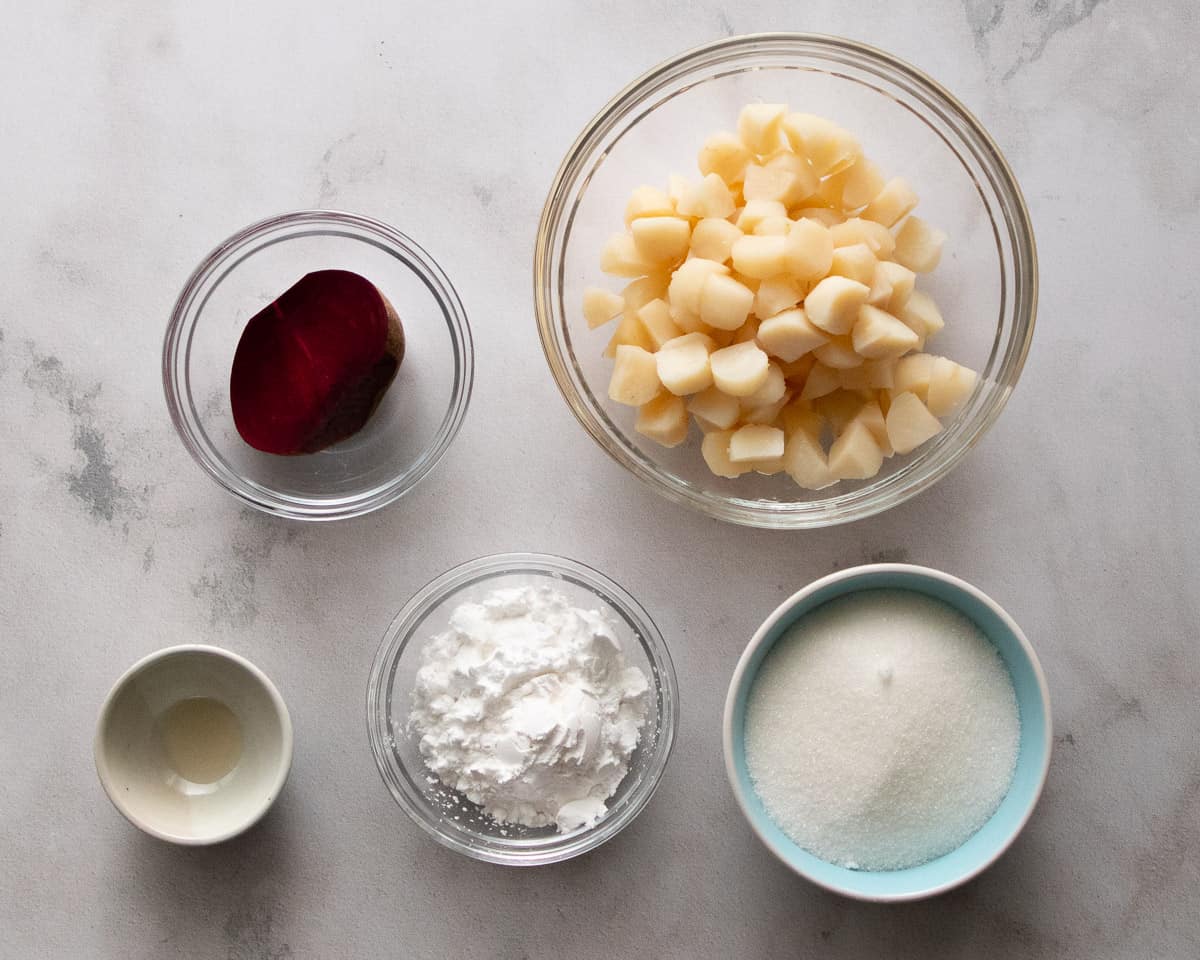

Water chestnuts are another popular tako filling, but I have made them red here as inspired by another classic Thai dessert, “red rubies“. If water chestnuts are not your thing, switch them out for young coconut, cooked taro cubes, or sweet corn!
- Water
- Beet, for colour, food colouring is okay too.
- Jasmine extract, coconut extract, vanilla extract, or another flavouring of your choice
- Mung bean starch
- Tapioca starch
- Sugar
- Cooked water chestnuts, canned
Top Layer Option 3 – Golden Pineapple
This is an unconventional tako flavour that I created, but it works super well because…pina colada, anyone? This also goes to show you that the sky’s the limit when it comes to creating your own flavours! Anything that goes with coconut will work, (and a LOT of things go with coconut)!
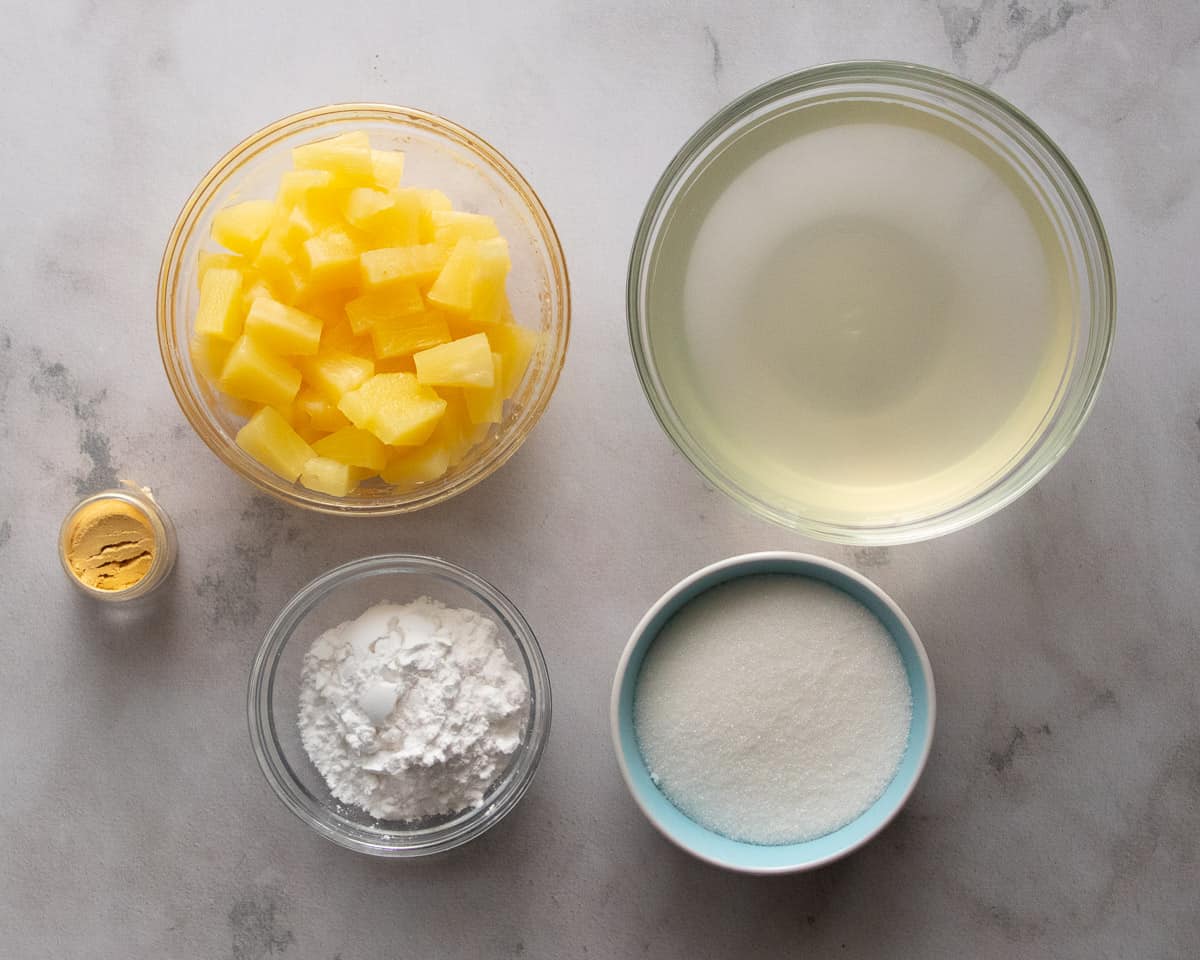

- Coconut water (pineapple juice will also work for a more pronounced pineapple flavour)
- Gold dust, optional, just for some flare!
- Mung bean starch
- Tapioca starch
- Sugar
- Pineapple, canned
How to Make Crystal Tako
The instructions are incredibly simple, and can be summed up in just one word: stir. That’s it, folks. That’s all you need to do! Here’s a bird’s eye view of the process, but I strongly suggest watching the full video tutorial to get a better idea of how it comes together and the texture that you are looking for – especially if you’ve never made it before!
For the Coconut Layer:


- In a small or medium saucepan, combine the rice flour with water and whisk until the flower is completely dissolved.
- Add the coconut milk, sugar, and salt and stir to combine.
- Stir the mixture over medium high heat, and once it starts to steam, turn it down to medium heat and cook until it’s fully thickened. About 5-8 minutes.
- Immediately spoon into cups until they are about half full. Do this while the pudding is hot, as it stiffens up once cooled; but if it does cool, simply reheat it on the stove to soften. Let cool while you make the topping.
For the Glossy Layer:




- Blend the pandan leaf with room temp or cold water until fine, then strain through a fine sieve.
- Combine the pandan leaf juice with the mung bean starch, tapioca starch, and sugar; then stir until the starch is dissolved.
- Cook over medium heat, stirring constantly with the rubber spatula until the mixture becomes thick and translucent; about five minutes.
- Once fully translucent, stir in the young coconut and cook for another minute to heat it up.
- Immediately spoon this over the coconut pudding, aiming for roughly the same amount for each layer. Do this while the pudding is hot as it stiffens up once cooled; but if it does cool, simply reheat it on the stove to soften.
- Let cool to room temp before serving. You can also garnish them with a little toasted coconut or coconut flakes to let people know of the presence of coconut if you like.
Want to try other flavours? The process for cooking the top is the same, you simply need to switch out the liquid and the mix-ins. You may need to reduce the amount of sugar if the liquid is already sweet, so do use some judgement as you make changes. Detailed instructions for the water chestnuts and pineapple versions are in the recipe card.
What is Mung Bean Starch?
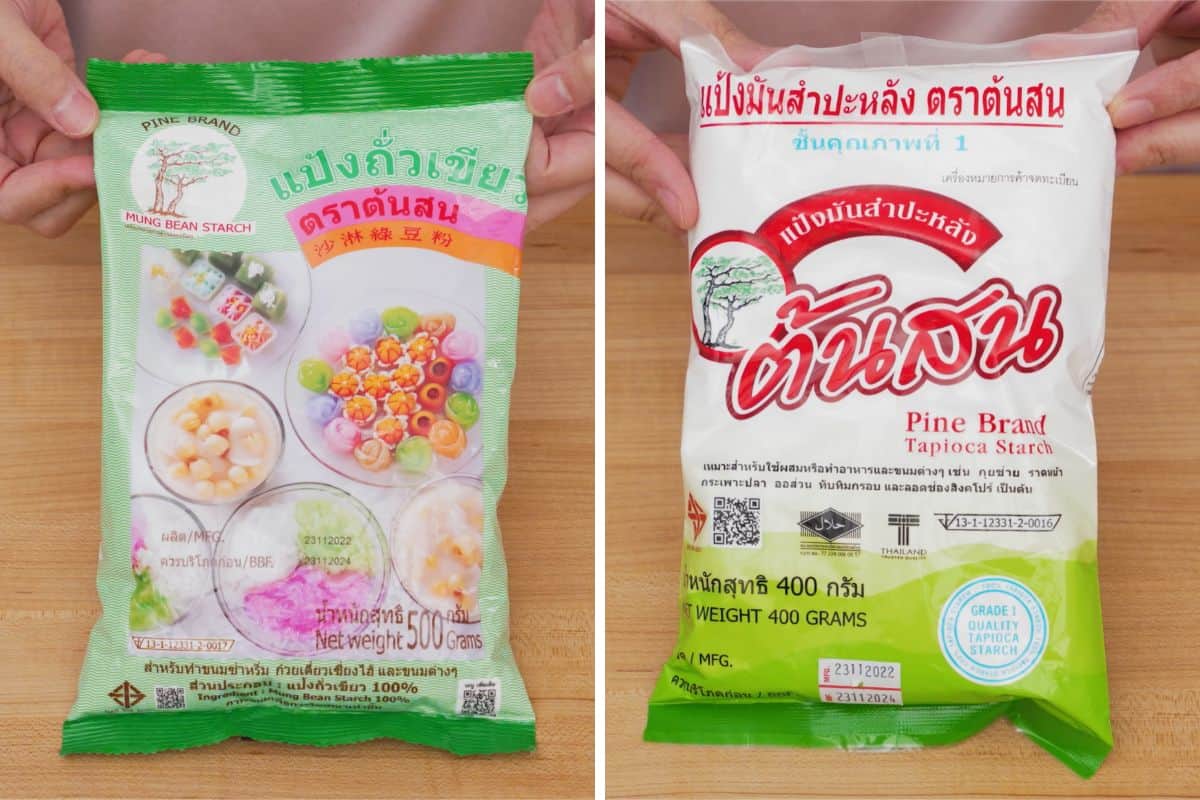

Let’s talk about our main ingredient, mung bean starch, which is responsible for the “crystal” quality of our pudding.
You know those bean sprouts in noodle soups and pad thai? Those are mung bean sprouts. And mung bean starch, is extracted from those beans. Mung bean starch is used in many Asian countries, but in Thailand it is used only in desserts and for making glass noodles.
Mung bean starch is used in tako because it has a tender texture, and the magical quality of being clear when cooked (hence, “glass” noodles!). So whenever clarity and translucence are required, mung bean starch comes to the rescue.
If I were to use cornstarch or rice flour for the top layer, for example, I would get a pudding, but it would be cloudy and not nearly as pretty as the ones you see here. Not to mention the mix-ins will not be clearly visible.
Tapioca starch also cooks up clear and has a chewier texture, so I add a small amount for added elasticity, but I want the mung bean starch to be our primary starch to maintain tenderness. You can omit the tapioca starch and replace it with the same amount of mung bean starch.
Once you have mung bean and tapioca starch, try making these bubble tea noodles and these no-churn Thai tea ice cream bars!
Where to buy mung bean starch and tapioca starch?
My preferred brand of mung bean starch is Pine Brand (sponsored), a popular Thai brand who also make my favourite glass noodles! You can look for it wherever you get your Thai groceries, check out this map of Asian grocery stores to find one near you.
Korean grocery stores also carry mung bean starch as it is also used in Korean cuisine; and any store that sells a lot of Southeast Asian groceries is a good place to look as they also use it in Malaysia, Singapore, and Indonesia as well.
Tapioca starch is much easier to find and is usually available at any Asian grocery stores, or even some health food stores. Arrowroot starch can also be used instead of tapioca starch.
IMPORTANT: Do NOT buy “mung bean flour” or “tapioca flour” (vs “starch”). These are not pure starches and will not work as a substitute.
What if I can’t find mung bean starch?
If you can’t find mung bean starch at all, there are a few options. First, you can use rice flour or cornstarch BUT…you will end up with a cloudy pudding that isn’t as pretty. In that case, consider sticking with the traditional version with the coconut side on top. If making the traditional version though, reduce the amount of rice flour in the coconut pudding to 30 g.
Or, consider doing something entirely different. Take a look at these colourful tako that I had in Thailand!


- You can make a tapioca pudding. The blue tako in the pic above is topped with tapioca pudding coloured with butterfly pea flowers (any food dye will also work). You can then stir in any of the mix-ins I’ve mentioned. See my video here for basic instructions for how to make tapioca pudding (as part of my “Is Your Sago FAKE or REAL?” video).
- The black one on the top left was my favourite of this bunch. It’s a black sticky rice pudding, and you can simply use my black sticky rice pudding recipe here! The orange threads on top is just a garnish of candied egg yolk threads, which you don’t need.
- FYI: The pink one is similar to the red water chestnut one I shared in my recipe, and the white one is the traditional tako, with candied water chestnut garnish on top to indicate that the bottom has water chestnuts inside.
Tips for Advance Prep
There are many ways to prepare tako in advance, but there is only 1 thing to keep in mind: the mung bean starch becomes cloudy when refrigerated, but the pudding will still taste great. So if the translucent look is important to you, it’s best not to chill them. The pudding will last all day at room temperature, and here are ways to get lots done ahead of time:
- Make the bottom coconut pudding layer and fill the cups up to one day ahead. Keep them covered in plastic wrap and refrigerate until serving day.
- Prep all your ingredients for the top layer ahead of time. The top layer only takes a few minutes to cook, so once you have the bottom done and the ingredients for the top prepped, you can finish it really quickly in the morning.
- If you have a dinner party, finish the pudding in the morning and they will last well into the evening without refrigeration.
- If you NEED to refrigerate them, that’s fine! You will lose the clarity, but they will still taste great, and some people even prefer them cold. You can also consider making the traditional version with the coconut layer on top, and you won’t have to worry about chilling them.
Storage
If you have tako leftover, keep them covered in the refrigerator and they will last at least 3 days. The top will turn cloudy as mentioned above, but they will still taste great. I find they even taste a bit better the next day because the ingredients have had time to mingle – especially the water chestnuts one.
You may find that a small amount of water pools around the top after a few days. This is normal and is totally fine; it’s just water seeping out of the pudding, and you can eat it or use paper towel to dab it.
They do not freeze well.
Other Flavour Ideas
I have given you a few different options to choose from, but here are some more ideas in case you want to branch out.
- Taro. I don’t always like taro, but I LOVE taro in tako. It will work as a sub for the young coconut in the green version. Simply peel and dice taro, and steam it for about 10 minutes or until tender (check often as you don’t want them turning into mush).
- Sweet corn. Another classic tako mix-ins. The canned stuff is fine here, and it would also work well with the green pandan base. I would even add it in addition to the young coconut for something prettier.
- Longans. Longans are a cousin to lychee, and you can find them canned at many Asian grocery stores. They are flavourful and juicy in themselves, so they’ll work with a neutral base of just water, coloured with whatever your heart desires.
- Fresh mango (or other sweet fresh fruits). I have not personally tried this, but I KNOW this is going to be so delish. This doesn’t even need to be cooked. Simply top the coconut pudding with some sweet, ripe mango pieces that are slightly mashed to get that creamy effect as done in this mango royale recipe. Sweeten it a little with honey as needed, and you’re good to go.
Choosing Containers for Tako
Tako is traditionally served in individual banana leaf cups, but any kind of small cups such as sauce cups, mini ramekins, mini foil tart pans, or silicone cupcake liners will work. The ideal volume, for me at least, is 2 oz (60 ml) or smaller.
Do not use paper muffin liners as they will just flop open and eventually the moist pudding will soak through. You need something that can hold their shape and is waterproof.
How to Make Your Own Banana Leaf Cups
If you’re feeling ambitious and want to make the traditional banana leaf cups, it’s not hard. Here are the supplies what you’ll need:
- Banana leaves, frozen or fresh
- A wet kitchen towel and a dry one.
- a round pattern about 3.5-4 inch in diameter. This can be a bowl, a jar lid or a cardboard cutout. Larger is okay, but not smaller.
- A small stapler
- Scissors
- A chef’s knife
- Tear the banana leaves into 4-inch wide strips along the grain of the leaves. You may need to use scissors to snip off the end if it’s stuck to the rib. Each tako cup will take 2 pieces, but cut a few extras in case of tears.
- Wipe both sides of each leaf clean with a wet towel, and dry them off again with a dry towel.
- Stack the banana leaf strips, lining them up along the short edge. Place your round pattern on top of the stack, then use a sharp chef’s knife to chop off excess around the pattern, so you will end up with a stack of round banana leaves in the end.
- Take two round pieces and place them on top of each other, making sure the grains of the leaves are perpendicular to each other. This will make them less likely to tear. (See pic below)
- Fold a small pleat about 1 inch long and use a small stapler to secure the pleat together. Make another pleat on the opposite side of the first pleat (pic step 3). Then make two more pleats in between the first 2 pleats (pic step 4). Your cup is done! These will last a few days in the fridge in a covered container.


Thai Crystal Coconut Pudding Recipe – Tako
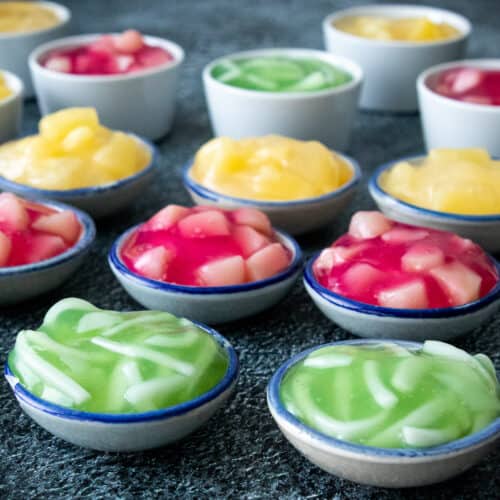

Crystal Coconut Pudding (Tako)
These traditional Thai layered coconut puddings have a creamy coconut base and a glossy “crystal” top that you can make into all kinds of flavours. They’re naturally vegan, gluten free, no-bake, super easy, and of course totally tasty – perfect for the holidays! I’ve given you 3 flavour options, but feel free to experiment!
Equipment
-
Small cups such as sauce bowls, espresso cups, mini aluminum tart pans, or silicone muffin cups. You can also make it in a big casserole dish or cake pan and scoop or cut to serve. Ideal volume for 1 cup is about 2 oz (60 ml) but it can be any size you want.
Ingredients
Base Layer – Coconut Pudding
Top Layer Option 1 – Green Pandan Coconut
Top Layer Option 2 – Red Water Chestnuts
Top Layer Option 3 – Golden Pineapple
Check Out Ingredients and Kitchen Tools I Use
Notes
- I recommend weighing the starch and flour in this recipe (use the metric toggle at the top of the ingredient list to show weight in grams), but if measuring by cup/tablespoon, fluff the starch to lighten it, then gently scoop without compacting and level it off with a straight edge. If you scoop into densely packed starch, or compact it as you scoop, you will end up with more than you need.
- If making the pineapple flavour, reduce the salt to ½ tsp. The salt is there to balance the sweetness of the top layer, but the acidity in the pineapple will also help balance the sweetness.
- Water chestnuts are rather plain tasting, so if you’d like to sweeten them soak them in hot simple syrup while you prep and make the bottom layer. You can also soak them a day ahead.
- You can also use pineapple juice instead of coconut water for a more pronounced pineapple flavour. If using, you will need to reduce the sugar to just 2 Tbsp; or omit it altogether if the juice is very sweet. If unsure, you can taste the cooked mixture and add more sugar as needed.
All my recipes come with step-by-step video tutorials with extra tips not mentioned in the blog post, so make sure you watch the video to ensure success. If you enjoy them, consider subscribing to the YouTube Channel to not miss an episode. Thank you!
Subscribe to my YouTube Channel
Instructions
Bottom Layer – Salted Coconut Pudding:
-
In a small pot, combine the rice flour with water and stir until completely dissolved. Add coconut milk, sugar and salt and stir to mix.
1.5 oz rice flour (about ⅓ cup + 2 Tbsp), ½ cup water, 1 ½ cups coconut milk, ¼ cup granulated sugar, ¾ teaspoon table salt
-
Cook the mixture over medium high heat, stirring constantly with a rubber spatula or a whisk, scraping the bottom as you go. Once the mixture starts to steam, lower the heat to medium and keep stirring. You will notice the mixture gradually getting thicker – keep stirring until it doesn’t look like it’s getting any thicker for at least 15 seconds – this means the mixture has fully thickened. If you stop stirring, the mixture should be bubbling. For this amount the process should take 5-8 minutes, depending on your heat. The final consistency should look like greek yogurt (I highly recommend watching the video to see what it should look like).
-
Right away, while the pudding is piping hot, spoon into your containers until about half full. Work quickly, as the pudding will stiffen as it cools, but if becomes too stiff simply heat it back up while stirring constantly over medium heat to soften it. If it’s hot and still feels too stiff, you can add a splash of water or coconut milk to loosen it up.
-
Let these cool at room temp while you make the top layer.
Top Layer option 1 – Green Pandan Coconut
-
Blend the pandan leaf with the water until fine. Strain into a liquid measuring cup and discard the fiber. Check to see that you have at least 1 ¼ cup of pandan juice; a little more is okay, but if you have less, add more water to make up the shortfall. If you want, add a few drops of green food coloring to intensify the colour.
1 pandan leaf, 1 ⅓ cups water, Few drops green food coloring
-
Pour the pandan juice into a small pot, then add the mung bean starch, tapioca starch, and sugar; stir until all the starch has dissolved.
3 tablespoon mung bean starch, 1 tablespoon tapioca starch, ⅓ cup sugar
-
Turn the heat on medium and stir constantly with a rubber spatula. As the mixture heats up, it’ll gel up bit by bit. Keep stirring constantly until the whole mixture has become thick and translucent. Once the mixture doesn’t look like it’s changing for a good 15 seconds, the pudding has fully cooked. Add the coconut meat and stir for a minute or so to allow the mixture to heat back up before turning off the heat.
¾ cup julienned young coconut meat
-
Right away, spoon the pudding over the coconut layer, aiming for roughly the same amount for each layer. If for some reason the mixture has cooled down and become too stiff to spoon, simply heat it back up while stirring constantly over medium heat to soften it.
-
Allow the pudding to cool to room temp before serving. (See storage notes in the blog post.)
Top Layer option 2 – Red Water Chestnuts
-
If you have a flat grater, grate the beet directly into the water until the colour intensity is the way you like it. If you have a box grater, grate about ¼ of a medium beet and put it into the water. Stir to extract the colour and strain the liquid into a small pot, pressing out all the water.
1 ¼ cups water, A quarter of a beet
-
Stir in mung bean starch, tapioca starch, sugar, and flavouring of your choice, if using; stir until the starch is all dissolved.
¼ teaspoon Jasmine extract or coconut extract, 3 tablespoon mung bean starch, 1 tablespoon tapioca starch, ⅓ cup + 1 tablespoon sugar
-
Turn the heat on medium and stir constantly with a rubber spatula. As the mixture heats up, it’ll gel up bit by bit. Keep stirring constantly until the whole mixture has become thick and translucent. Once the mixture doesn’t look like it’s changing for a good 15 seconds, the pudding has fully cooked. Add the water chestnuts and stir for another minute to allow the mixture to heat back up before turning off the heat.
1 cup cooked or canned water chestnuts
-
Right away, spoon the pudding over the coconut layer, aiming for roughly the same amount for each layer. If for some reason the mixture has cooled down and become too stiff to spoon, simply heat it back up while stirring constantly over medium heat to soften it.
-
Allow the pudding to cool to room temp before serving. (See storage notes in the blog post.)
Top Layer option 3 – Golden Pineapple
-
In a pot, combine the coconut water and the gold dust (if using) until it looks the way you like it, adding more gold dust if desired. Then add the mung bean starch, tapioca starch, and sugar; stir until the starches have completely dissolved.
1 ¼ cups coconut water, ¼ teaspoon edible gold dust, 3 tablespoon mung bean starch, 1 tablespoon tapioca starch, ⅓ cup sugar
-
Turn the heat on medium and stir constantly with a rubber spatula. As the mixture heats up, it’ll gel up bit by bit. Keep stirring constantly until the whole mixture has become thick and translucent. Once the mixture doesn’t look like it’s changing for a good 15 seconds, the pudding has fully cooked. Add the pineapple pieces and stir for another minute to allow the mixture to heat back up before turning off the heat.
1 cup canned pineapple rings
-
Right away, spoon the pudding over the coconut layer, aiming for roughly the same amount for each layer. If for some reason the mixture has cooled down and become too stiff to spoon, simply heat it back up while stirring constantly over medium heat to soften it.
-
Allow the pudding to cool to room temp before serving. (See storage notes in the blog post.)
Watch my videos AD-FREE and get bonus content on Patreon!
Want more delicious vegan coconut desserts?
Thai cuisine is filled with naturally vegan desserts, and almost all of them include coconut and are gluten free. So check out all of my dessert recipes, but I’ve highlighted a few vegan ones here:

